Review round-up: active-pickup electric guitars
Next-level humbucker electrics from Jackson, Schecter, Squier and Fret-King
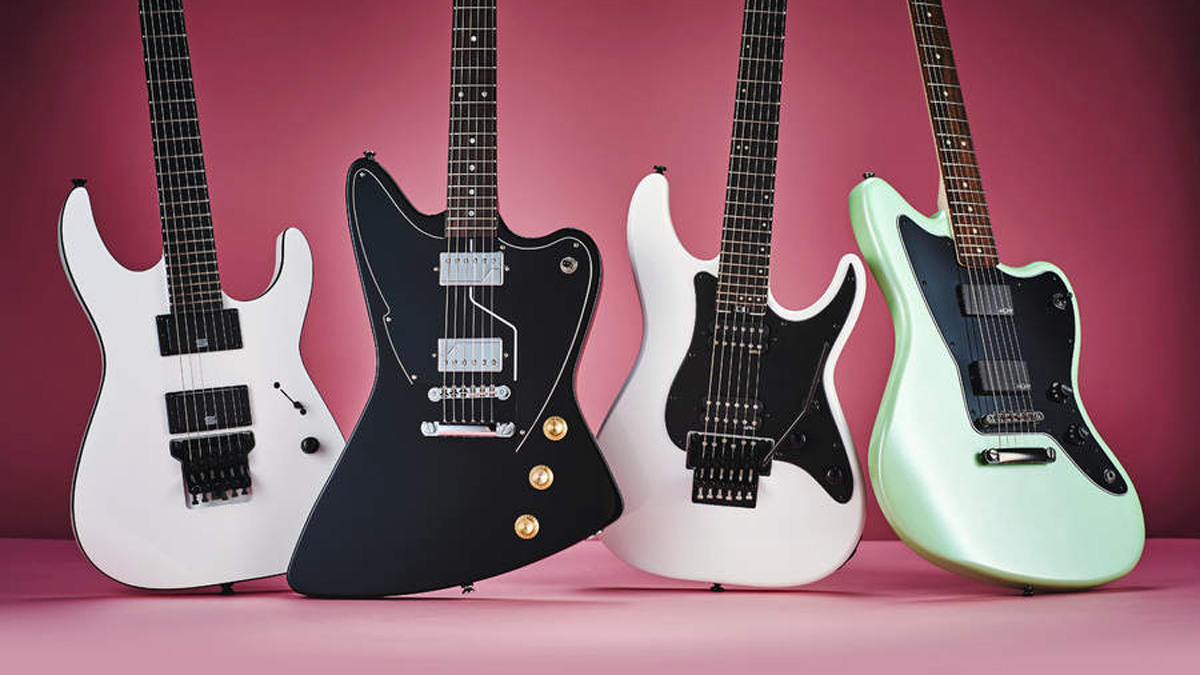
Once upon a time you’d have only found active pickups on basses, but inevitably the guitarists got in on the act.
Those players who like their hair long, their T-shirts black and their tone capable of sawing through concrete were especially alive to the active pickup’s potential. An onboard preamp, powered by a nine-volt battery typically housed in the instrument’s rear, allows the active pickup to maximise gain with minimal hum.
But wait a minute: the war on hum is something all players can get behind, right? Not to mention that hum-killing isn’t the only benefit. Active pickups have excellent frequency response, losing little of the high end that’s often sacrificed in high-output passive pickups.
This round-up shows how active humbuckers can be deployed in a variety of contexts. The Squier Jazzmaster sees them housed in an old-school offset body to create an off-kilter metal guitar; similarly, the Fret-King Esprit, albeit with a more vintage-voicing and creative electronics to increase its range, throws a lesser-spotted shape into focus.
The Schecter Sun Valley Shredder offers hot-for-teacher 80s lead tone, while Mick Thomson’s signature Pro Series Jackson offers the nuclear option... Should you have any concrete that needs sawing.
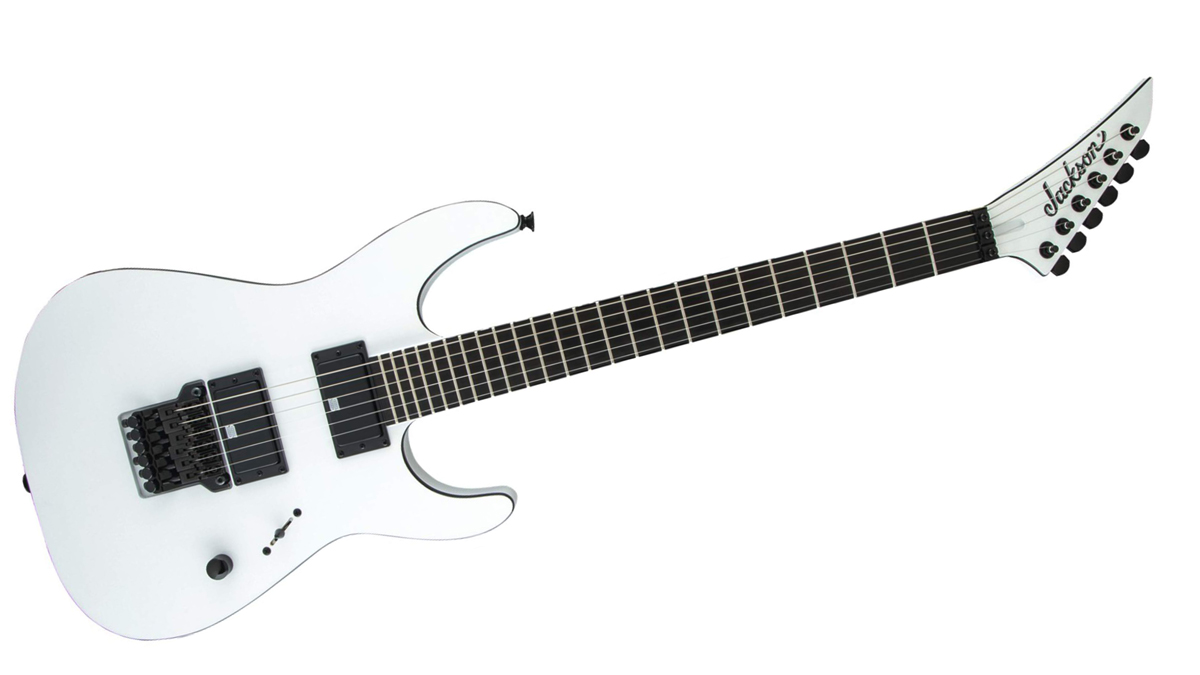
Jackson Pro Series Mick Thomson SL2 Soloist
Oi! I’ve opened the box - now where’s my whammy bar?
Oh yes, while it looks like big Mick’s Soloist is routed with a floating vibrato, what with its Floyd Rose-esque vibe, it’s really a hardtail with a locking nut; so you can tune it and lock it, and fine-tune where appropriate. But before you cry foul, just remember: this thing is never going out of tune.
There’s no tone knob, either?
Nope. In its absence, it’s best to consider the SL2 Soloist to come already set at 10, then ask yourself when was the last time you played some ripping metal and had your guitar’s tone set to anything less than 10?
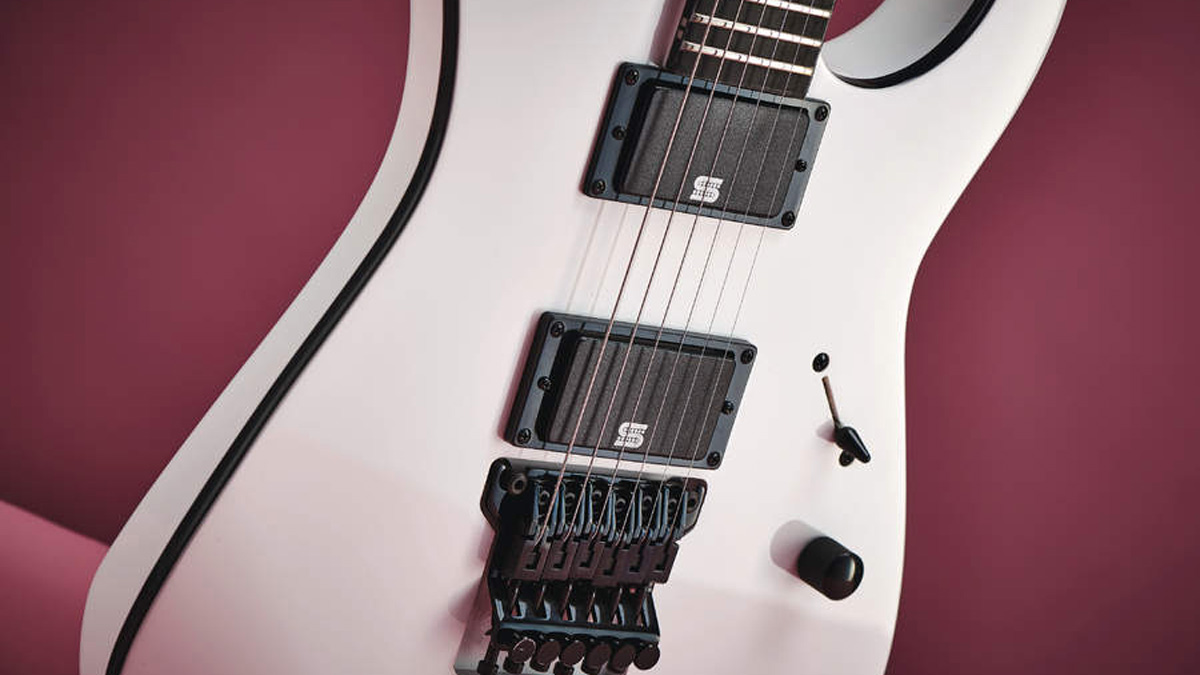
What’s so special about the pickups?
The pickups on the SL2 Soloist are genuine Seymour Duncan signature Blackouts, custom-wound to Mick Thomson’s spec. “I had them tighten up the bottom because tuning low like we are, you don’t need that lower ‘woof,’” says Mick. “And I had the top-end adjusted a little bit for more cut without being harsh or scratchy.” They clean up real good, too - sparkling, articulate, and ready for church on Sunday.
At A Glance
Key features: Mahogany body, maple neck, 24 jumbo frets, 25.5” scale, 12-16” compound radius ebony fretboard, 2x Seymour Duncan Mick Thomson Signature Blackout AHB-3S humbuckers, Jackson MTB HT6 Hardtail bridge, locking nut
Finish: Snow White (as reviewed), Black
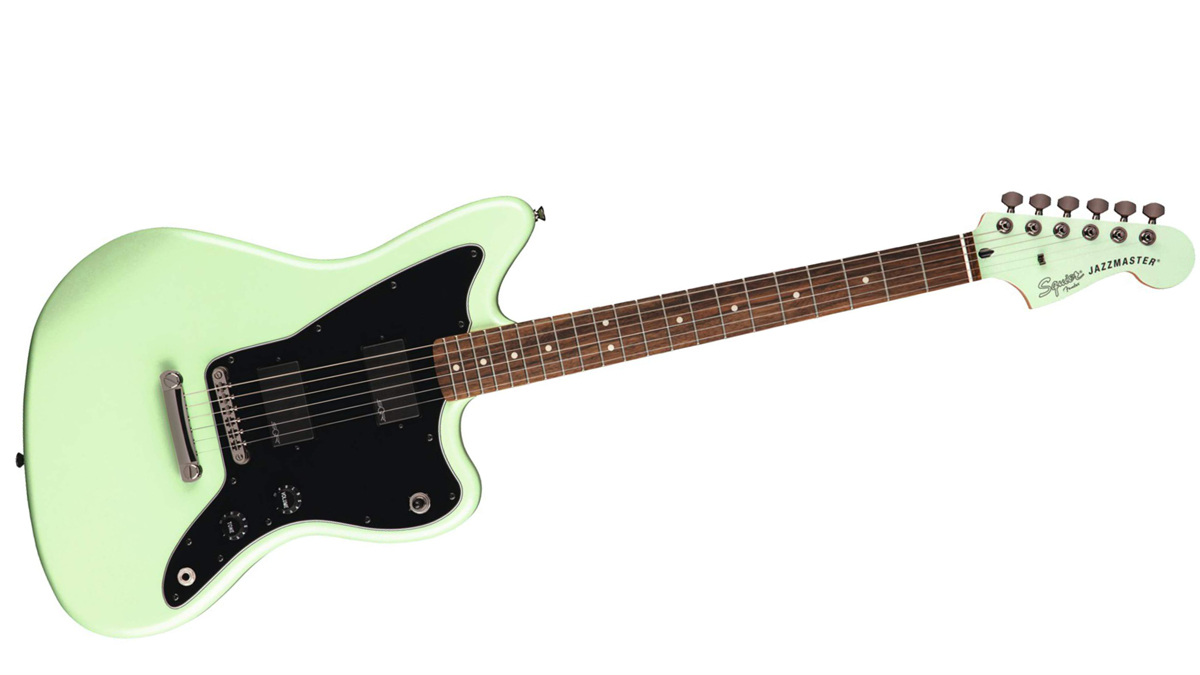
Squier Contemporary Active Jazzmaster
Isn’t the Jazzmaster all switches?
Well, you’re right, but this is one stripped-down Jazzmaster. There is no rhythm or lead circuit like you’d find on the classic Jazzmaster: this takes the road of the American Pro, with just a three-way pickup selector, master volume and tone - albeit the selector is on the treble cutaway, making it easier to access. Really, it’s a matter of taking the body shape and running with it.
And there’s no vibrato?
No. In its place is a tidy little adjustable fixed bridge with a stop-bar tailpiece - making quick tweaks to intonation or string height a genuine cinch.
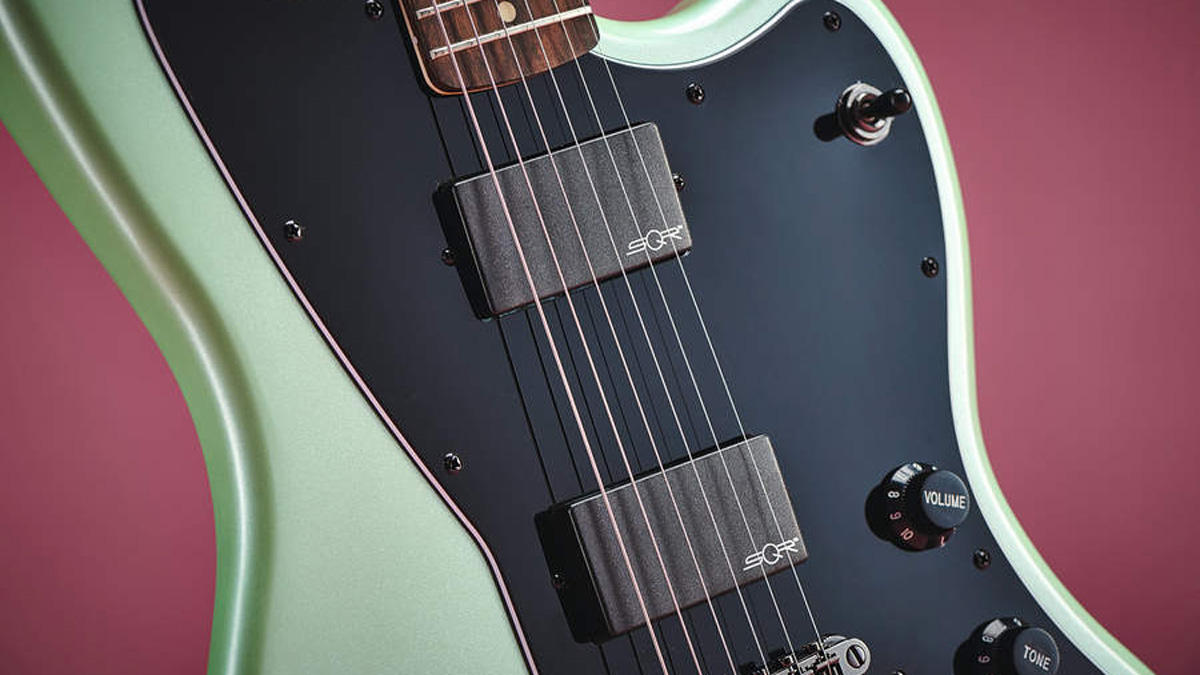
Can you play jazz on this?
Sure: get a clean tone, engage the neck humbucker and roll a little tone back, and it has that woody piano-esque thing going on. But c’mon, no-one really played Jazz on Jazzmasters. The classic 60s models were played by surf-rockers and latterly grunge players, so playing metal on this, as these high-output Squier humbuckers command you do, is really not going to throw your chakra all out of whack.
At A Glance
Key features: Poplar body, maple neck, laurel fretboard, 25.5” scale, 2x Active SQR Ceramic humbuckers, master volume, tone, adjustable stop-bar tailpiece
Finish: Surf Pearl [as reviewed], Graphite Metallic
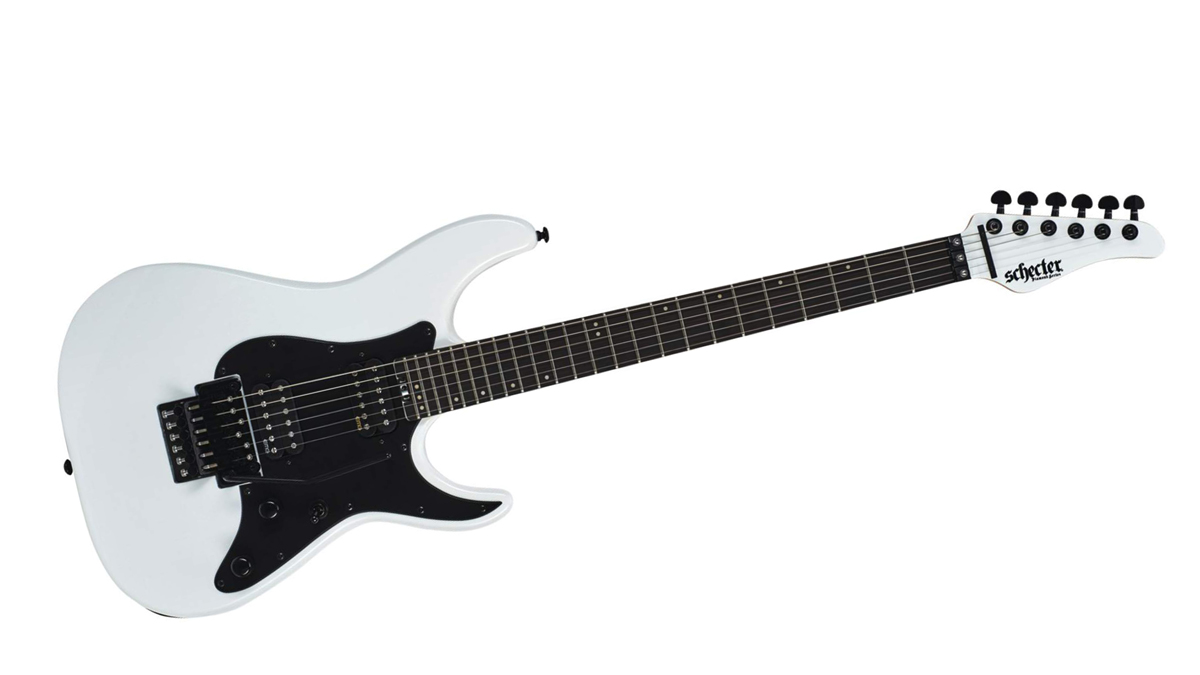
Schecter Sun Valley Super Shredder FR
Is there a more appropriately named guitar on the market?
What, Sun Valley? That sounds like a generic orange juice. Oh, the Shredder part? Yes, Schecter isn’t playing with this one; this is one from the 80s playbook of hot-rodded S-style guitars, with hot pickups and a Schecter-exclusive Floyd Rose locking vibrato for wild whammy bar action.
These EMGs don’t look like the ones we usually see...
No - with its open-coil design, the Hot 70 humbucker has a classic look. And it’s not by accident: these are wound with late-70s rock tones in mind. The EMG website says ZZ Top and EVH, and that’s a bang-on assessment, because these are for the metal or hard-rock player who might have found the scooped tones of Metallica’s mid-80s performances too harsh.
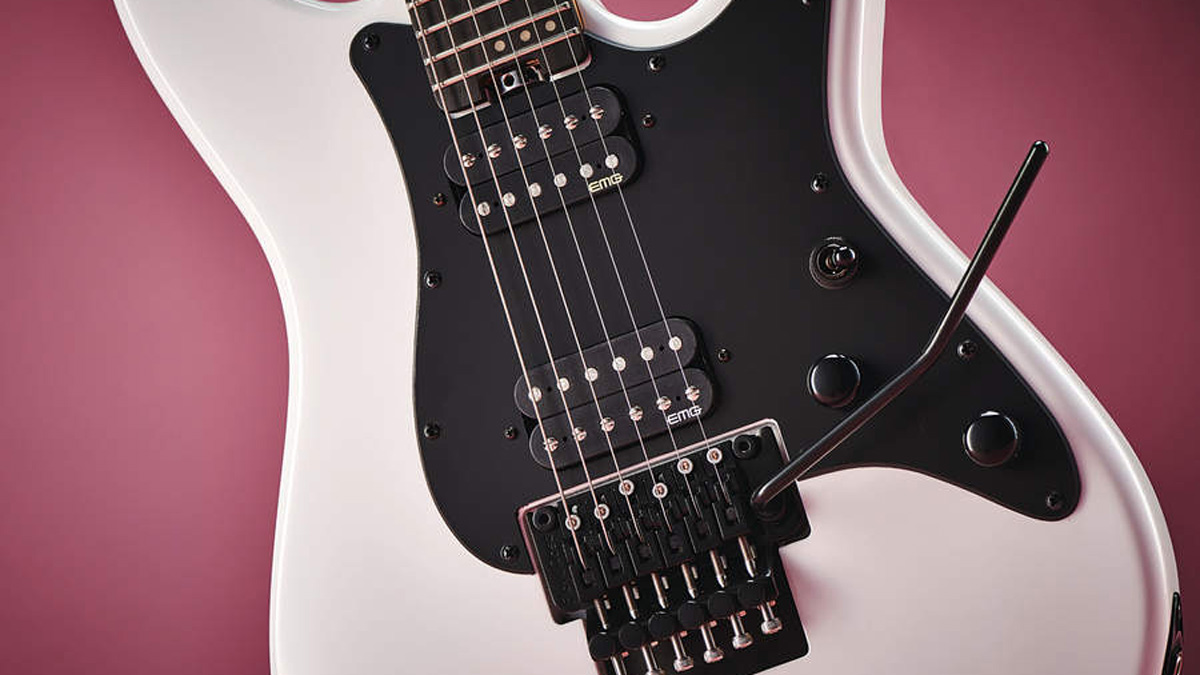
Is the neck super-skinny?
We wouldn’t say super-skinny. It’s a svelte ’n’ satin-smooth C-profile neck. It’s comfortable and it won’t gum up on you when you sweat. The frets are nice and fat as well, so they’re guaranteed to add some zip to your lead playing. That’s what the Super Shredder is all about.
At A Glance
Key features: Mahogany body, maple neck, 24 extra jumbo frets, rosewood fretboard, 25.5” scale, 2x EMG Retro Active Hot 70 humbuckers, 2x volume controls, 1x three-way pickup selector, Floyd Rose Special ‘Hot Rod’ Locking vibrato
Finish: Gloss White (as reviewed), Satin Black, Lambo Orange

Fret-King Esprit V Fluence
So the body is made from agathis? Agathis who?
Agathis, the timber cut from the evergreen kauri tree that grows extensively across the Indo-Pacific. Used as an alternative to basswood, it’s often sniffed at among tonewood afficionados, but don’t listen to that sort of talk. The Esprit V sounds incredible - and despite using a huge plank of it here for the off-set body profile, it’s forgiving on the lower back, too.
Tell us more about the Fluence pickups...
They are made by Fishman, and they are expensive. That you are finding them on a guitar that retails for under £700 is probably down to Fret-King and Fishman sharing a distributor. With a push/ pull control, the Fluence pickups each have two voices, and will challenge any preconceptions of active pickups lacking dynamism.
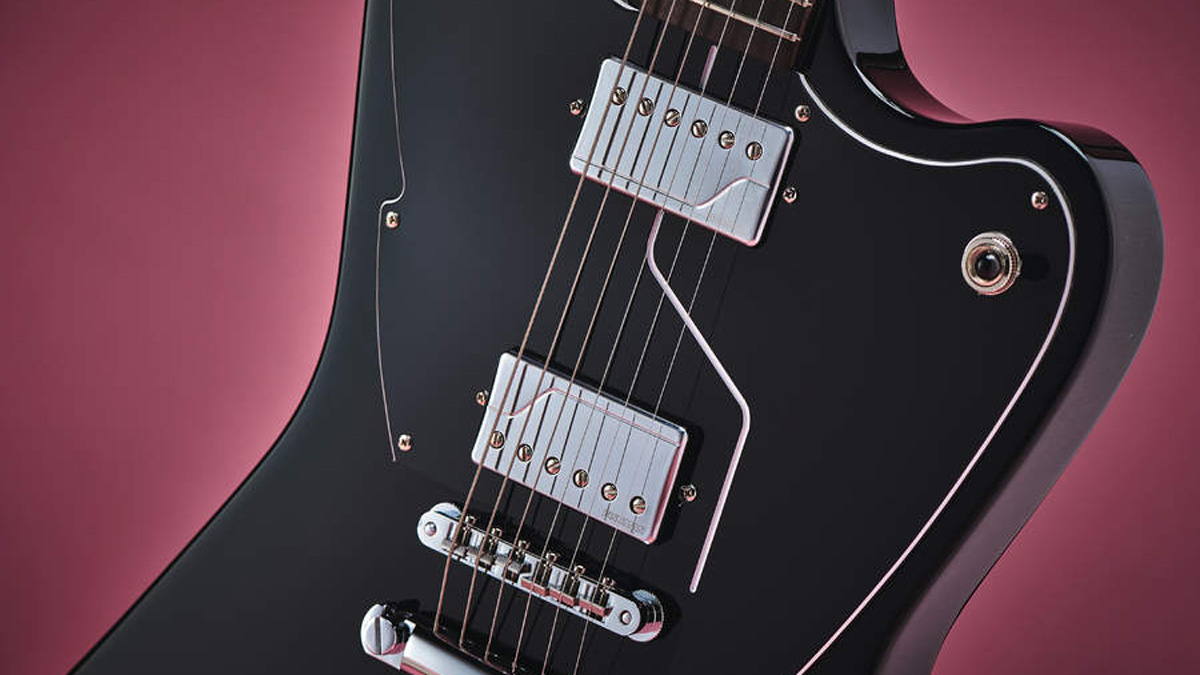
Okay, but the body looks weird.
It does, and it’s pretty great, right? It’s an off-set that makes you think of the likes of Jazzmaster, Explorer, Firebird, and so on, but it’s also got a pawnshop curio vibe that we think is very cool. Helpfully, it’s nicely balanced when played seated or standing, so you’re covered for most eventualities.
At A Glance
Key features: Agathis body, maple neck (set), 25” scale, 22 medium-jumbo frets, rosewood fretboard, 2x Fishman Fluence TFL101 active humbuckers, 2x volume, 2x tone, 3-way pickup selector and push-button Fluence switch, Wilkinson Tune-O-Matic-style bridge
Finish: Gloss Black only
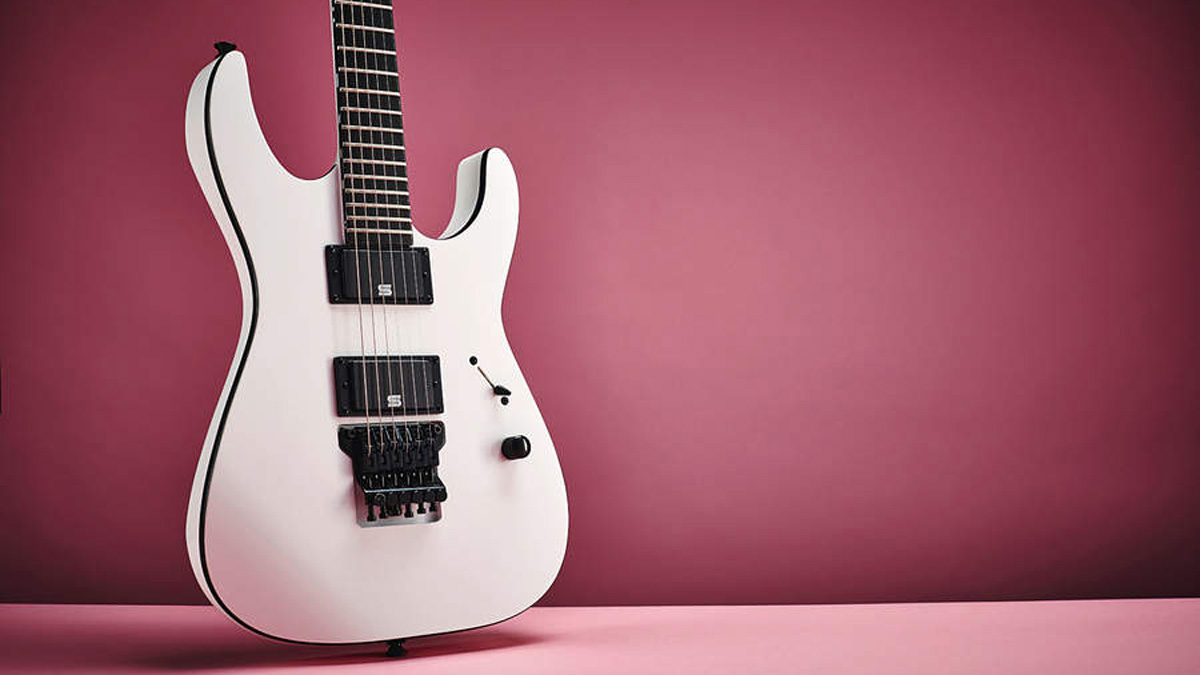
Head to Head
If you were to order these in order of tonal extremity, you’d have the Jackson first, followed in turn by the Squier Contemporary Jazzmaster, the Schecter Super Shredder, and the Fret-King. But such a sliding scale offers few insights to how they perform.
We love how pared back Mick Thomson’s Soloist is - there isn’t even a truss-rod cover - and a hardtail bridge with locking tuners is practical for riffing hard. The Jackson’s sustain, facilitated by its Seymour Duncan Blackouts and neck-through construction, is quite breathtaking. Likewise the Fret-King: its neck is way more clubby, and glued to the body for a Gibson-esque feel. But with a 25-inch scale and the duality of the Fluence pickups’ voice - which offers thick, creamy rock or sharp and bright sizzle - it’s a bipartisan offering that’ll appeal to Fender and Gibson tribes alike. With cleaner tones, the Fret-King is a blues master, bright and sharp, and dialling in a little more gain brings forth a tone that’s made for channelling those big beasts of 70s rock.
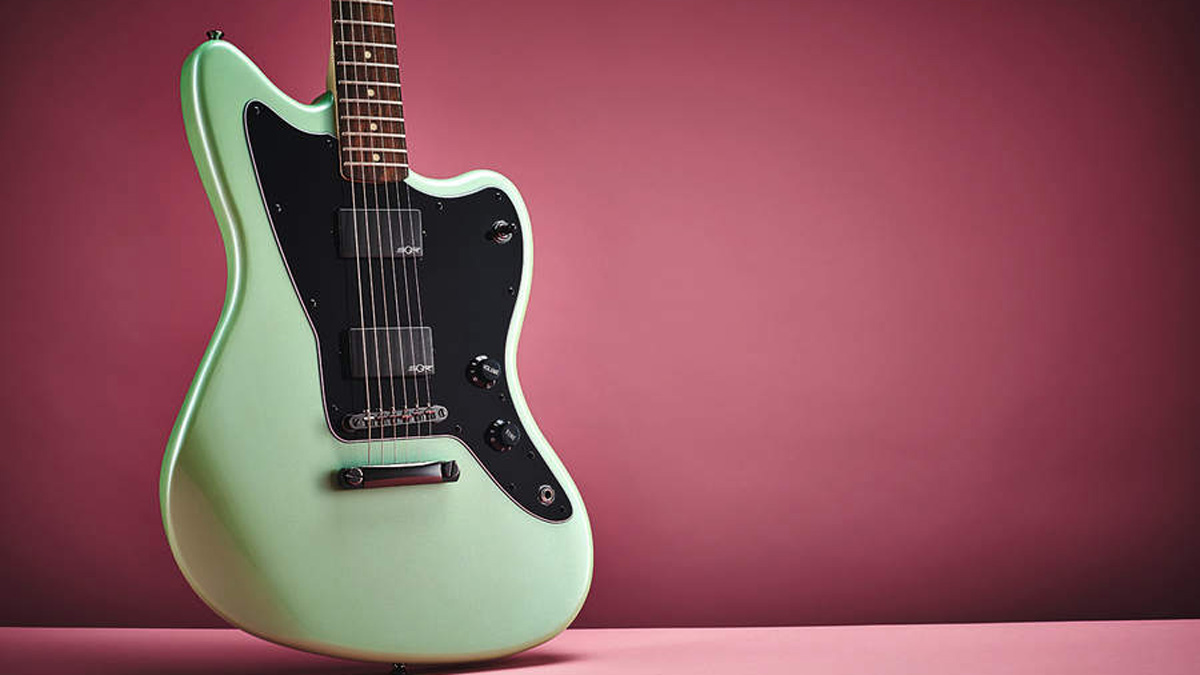
The Squier looks like a modern update of the 60s Jazzmasters, with what feels like a slimmer neck, but its power will give pause to anyone tuning in expecting some P-90 hot-soup tone. Likewise its 21-fret fingerboard may be seen to some as a disqualifying factor for playing metal or shred.
Those complaints won’t be echoed on the full two-octave fretboard of the Schecter. It’s the only instrument here with a floating vibrato, offering harmonic gymnastics once the gain gets past two o’clock on your dial. Once your signal begins to break up, that’s when the Super Shredder comes alive. The harmonic response is incredible.
While the volume is matched across both ’buckers, the neck pickup, with its Alnico 5 magnet, is a little more vintage, more subtle for chewy blues leads; while the bridge pickup is hotter, all crunch and attitude.
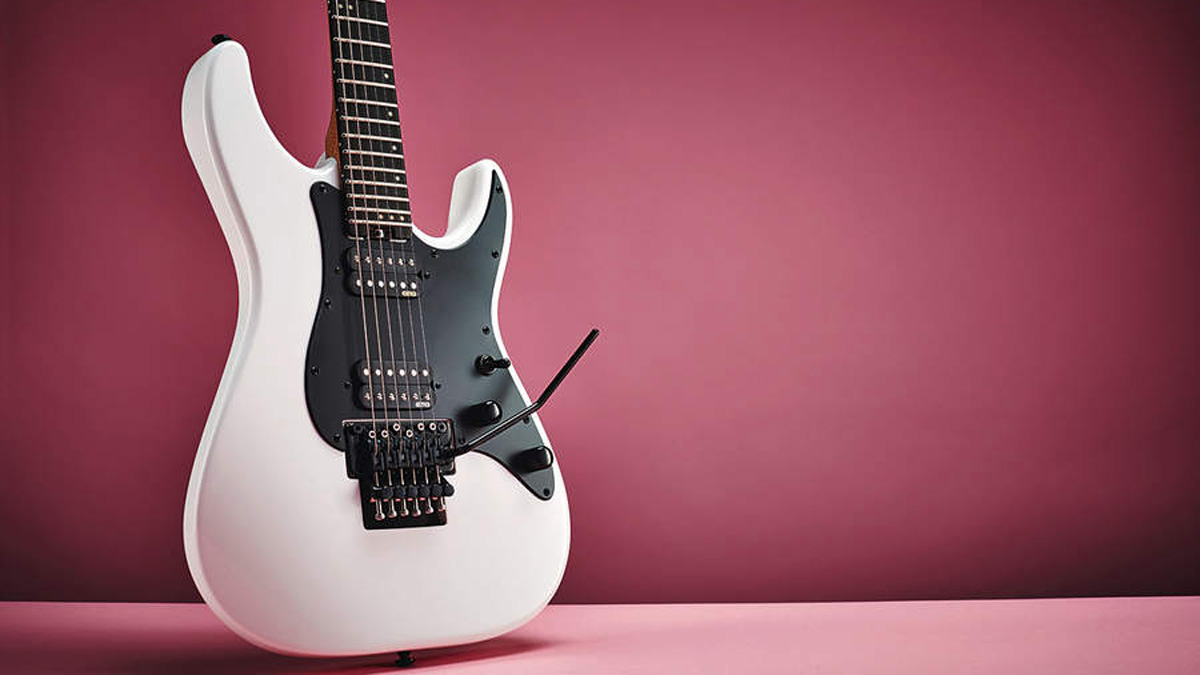
Final Verdict
There is a common misconception that all guitars equipped with active pickups sound alike.
But is it not more the case that guitarists using said guitars are chasing the most brutal metal tone possible, and that this engenders conformity at sonic extremes? These four electrics seem to bear that theory out. Of course, all are capable of articulating a riff in super-high-gain scenarios, but there’s a world of difference between the Fret-King - or even the Schecter - and Mick Thomson’s Jackson.
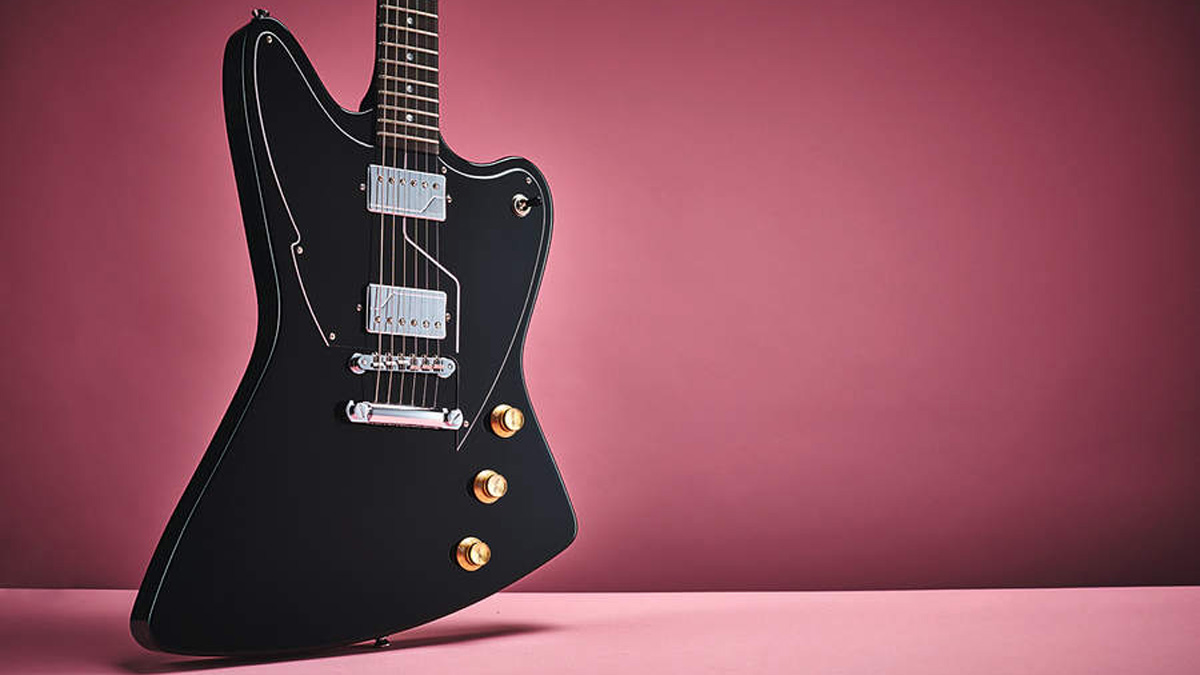
If you’re after the ultimate metal guitar, then it’s the Mick Thomson Soloist. Its harmonic response and note separation when playing through filthy levels of gain is unbeatable. But the Jazzmaster is no slouch: we love its super-cool Surf Pearl finish, and it’s a fun guitar - a winner for those who feel grunge needs more distortion and less feedback. Maybe grunge needs the Fret-King; here, Trevor Wilkinson has tastefully appointed a big plank of wood and blessed it with great feel and a classic tone that’s dynamic, raw and organic. Anyone with doubts over active pickups as a mainstream option should give it a spin. The Super Shredder is similarly an R&D triumph, featuring two of the coolest humbuckers EMG has ever produced. For a souped-up, hard-rockin’ metal S-style, it’s a gig-worthy instrument at an excellent price.
Best for metal: Jackson Pro Series Mick Thomson SL2 Soloist
4.5 out of 5
Best value: Squier Contemporary Active Jazzmaster
4 out of 5
Best for shred: Schecter Sun Valley Super Shredder FR
4.5 out of 5
Best for classic rock: Fret-King Esprit V Fluence
4.5 out of 5
Jonathan Horsley has been writing about guitars and guitar culture since 2005, playing them since 1990, and regularly contributes to MusicRadar, Total Guitar and Guitar World. He uses Jazz III nylon picks, 10s during the week, 9s at the weekend, and shamefully still struggles with rhythm figure one of Van Halen’s Panama.


